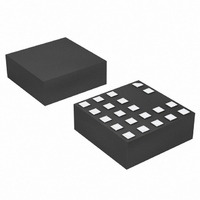LTM8020MPV#PBF Linear Technology, LTM8020MPV#PBF Datasheet - Page 8

LTM8020MPV#PBF
Manufacturer Part Number
LTM8020MPV#PBF
Description
IC DC/DC UMODULE 200MA 21-LGA
Manufacturer
Linear Technology
Series
µModuler
Type
Point of Load (POL) Non-Isolatedr
Datasheet
1.LTM8020EVPBF.pdf
(16 pages)
Specifications of LTM8020MPV#PBF
Output
1.25 ~ 5 V
Number Of Outputs
1
Power (watts)
1W
Mounting Type
Surface Mount
Voltage - Input
4 ~ 36 V
Package / Case
21-LGA
1st Output
1.25 ~ 5 VDC @ 200mA
Size / Dimension
0.25" L x 0.25" W x 0.09" H (6.25mm x 6.25mm x 2.32mm)
Power (watts) - Rated
1W
Operating Temperature
-55°C ~ 125°C
Lead Free Status / RoHS Status
Lead free / RoHS Compliant
3rd Output
-
2nd Output
-
Available stocks
Company
Part Number
Manufacturer
Quantity
Price
LTM8020
APPLICATIONS INFORMATION
For most applications, the design process is straight
forward, summarized as follows:
1. Look at Table 1 and find the row that has the desired
2. Apply the C
While these component combinations have been tested for
proper operation, it is incumbent upon the user to verify
proper operation over the intended system’s line, load and
environmental conditions.
If an output voltage other than those listed in Table 1 is
desired, use the equation R
where R
C
output voltage that most closely matches the intended
application, and verify proper operation over the system’s
line, load and environmental conditions.
Capacitor Selection Considerations
The C
minimum recommended values for the associated oper-
ating conditions. Applying capacitor values below those
indicated in Table 1 is not recommended, and may result
in undesirable operation. An input system bulk capacitor
is assumed. Using larger values is generally acceptable,
and can yield improved dynamic response, if it is neces-
sary. Again, it is incumbent upon the user to verify proper
operation over the intended system’s line, load and envi-
ronmental conditions.
Ceramic capacitors are small, robust and have very low
ESR. However, not all ceramic capacitors are suitable.
X5R and X7R types are stable over temperature and ap-
plied voltage and give dependable service. Other types,
including Y5V and Z5U have very large temperature and
voltage coefficients of capacitance. In an application cir-
cuit they may have only a small fraction of their nominal
capacitance resulting in much higher output voltage ripple
than expected.
Ceramic capacitors are also piezoelectric. The LTM8020’s
switching frequency depends on the load current, and
at light loads it can excite a ceramic capacitor at audio
8
IN
input range and output voltage.
on that row.
and C
IN
ADJ
and C
OUT
is in kΩ. As a starting point, use values for
IN
that correspond to the input voltage and
, C
OUT
OUT
capacitor values in Table 1 are the
, R
ADJ
and BIAS connection indicated
ADJ
= 623.75/(V
OUT
– 1.25),
frequencies, generating audible noise. Since the LTM8020
operates at a lower current limit during Burst Mode opera-
tion, the noise is typically very quiet to a casual ear.
If this audible noise is unacceptable, use a high performance
electrolytic capacitor at the output. The input capacitor can
be a parallel combination of a 2.2μF ceramic capacitor and
a low cost electrolytic capacitor.
A final precaution regarding ceramic capacitors concerns
the maximum input voltage rating of the LTM8020. A
ceramic input capacitor combined with trace or cable
inductance forms a high Q (under damped) tank circuit.
If the LTM8020 circuit is plugged into a live supply, the
input voltage can ring to twice its nominal value, possi-
bly exceeding the device’s rating. This situation is easily
avoided; see the Hot-Plugging Safely section.
Shorted Input Protection
Care needs to be taken in systems where the output will be
held high when the input to the LTM8020 is absent. This
may occur in battery charging applications or in battery
backup systems where a battery or some other supply
is diode ORed with the LTM8020’s output. If the V
is allowed to float and the SHDN pin is held high (either
by a logic signal or because it is tied to V
LTM8020’s internal circuitry will pull its quiescent current
from its output. This is fine if your system can tolerate a
few milliamps in this state. If you ground the SHDN pin,
this quiescent current will drop to essentially zero. How-
ever, if the V
high, then parasitic diodes inside the LTM8020 can pull
large currents from the output through the internal power
switch, possibly damaging the device. Figure 2 shows a
circuit that will run only when the input voltage is present
and that protects against a shorted or reversed input.
Figure 2. Diode D1 Prevents a Shorted Input from Discharging
a Backup Battery Tied to the Output, as Well as Protecting the
LTM8020 from a Reversed Input
IN
V
pin is grounded while the output is held
IN
1M
100k
D1
V
SHDN
IN
LTM8020
GND
8020 F02
IN
), then the
IN
8020fd
pin













